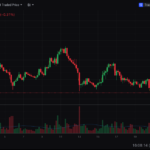Arbitrage trading is a popular strategy among traders looking to profit from price differences of the same asset across different markets. By simultaneously buying and selling an asset where it is undervalued and overvalued, traders can lock in risk-free profits. While the concept is simple, successful arbitrage requires speed, precision, and access to the right tools.
What is Arbitrage Trading?
Arbitrage is the practice of exploiting price differences for the same asset in different markets. These discrepancies typically occur due to market inefficiencies and can last for seconds or minutes before being corrected.
For example:
- Scenario: Bitcoin is priced at $50,000 on Exchange A and $50,500 on Exchange B.
- Action: A trader buys Bitcoin on Exchange A and sells it on Exchange B, pocketing the $500 difference (minus fees).
Types of Arbitrage Strategies
- Spatial Arbitrage:
- Involves trading the same asset across different exchanges.
- Example: Buying Ethereum on Binance and selling it on Coinbase.
- Triangular Arbitrage:
- Involves three assets and takes advantage of price differences in currency pairs.
- Example: A trader exchanges Bitcoin for Ethereum, Ethereum for USDT, and USDT back to Bitcoin to capitalize on small price gaps.
- Statistical Arbitrage:
- Relies on quantitative models to identify price disparities based on historical patterns.
- Example: Using algorithms to spot temporary mispricings in correlated assets.
- DeFi Arbitrage:
- Exploits price differences in decentralized finance (DeFi) platforms.
- Example: Buying a token on one decentralized exchange (DEX) and selling it on another.
- Futures Arbitrage:
- Involves differences between spot market prices and futures contract prices.
- Example: Buying Bitcoin on the spot market and simultaneously selling a futures contract when futures are overpriced.
How to Get Started with Arbitrage Trading
- Choose the Right Markets:
- Focus on assets with high liquidity and trading volume to minimize slippage.
- Monitor Prices:
- Use tools like price trackers, APIs, or arbitrage scanners to detect discrepancies in real time.
- Open Accounts on Multiple Platforms:
- Ensure you have active accounts on the exchanges where price gaps frequently occur.
- Consider Transaction Costs:
- Factor in trading fees, withdrawal fees, and network transaction costs to calculate net profitability.
- Utilize Automation:
- Many arbitrage opportunities disappear within seconds, making automated trading bots essential for execution.
- Understand Regulations:
- Ensure compliance with regional laws and exchange policies, especially regarding taxes and fund transfers.
Advantages of Arbitrage Trading
- Low Risk: Arbitrage is often considered a low-risk strategy as it exploits guaranteed price differences.
- Market Neutral: The strategy is not affected by broader market trends, as profits come from discrepancies, not market direction.
- Scalability: Traders can execute multiple arbitrage trades simultaneously across various markets.
Challenges in Arbitrage Trading
- Transaction Fees:
- High fees can erode profits, especially for small price differences.
- Execution Speed:
- Market inefficiencies correct quickly, so delayed execution can result in missed opportunities.
- Capital Requirements:
- Arbitrage trading often requires significant capital to make meaningful profits.
- Regulatory Risks:
- Some jurisdictions impose restrictions on cross-border fund transfers, limiting opportunities.
- Market Risks:
- Unexpected price swings during execution can lead to losses, especially in volatile markets.
Understanding Arbitrage Trading: A Beginner’s Guide
Arbitrage trading is a popular strategy among traders looking to profit from price differences of the same asset across different markets. By simultaneously buying and selling an asset where it is undervalued and overvalued, traders can lock in risk-free profits. While the concept is simple, successful arbitrage requires speed, precision, and access to the right tools.
What is Arbitrage Trading?
Arbitrage is the practice of exploiting price differences for the same asset in different markets. These discrepancies typically occur due to market inefficiencies and can last for seconds or minutes before being corrected.
For example:
- Scenario: Bitcoin is priced at $50,000 on Exchange A and $50,500 on Exchange B.
- Action: A trader buys Bitcoin on Exchange A and sells it on Exchange B, pocketing the $500 difference (minus fees).
Types of Arbitrage Strategies
- Spatial Arbitrage:
- Involves trading the same asset across different exchanges.
- Example: Buying Ethereum on Binance and selling it on Coinbase.
- Triangular Arbitrage:
- Involves three assets and takes advantage of price differences in currency pairs.
- Example: A trader exchanges Bitcoin for Ethereum, Ethereum for USDT, and USDT back to Bitcoin to capitalize on small price gaps.
- Statistical Arbitrage:
- Relies on quantitative models to identify price disparities based on historical patterns.
- Example: Using algorithms to spot temporary mispricings in correlated assets.
- DeFi Arbitrage:
- Exploits price differences in decentralized finance (DeFi) platforms.
- Example: Buying a token on one decentralized exchange (DEX) and selling it on another.
- Futures Arbitrage:
- Involves differences between spot market prices and futures contract prices.
- Example: Buying Bitcoin on the spot market and simultaneously selling a futures contract when futures are overpriced.
How to Get Started with Arbitrage Trading
- Choose the Right Markets:
- Focus on assets with high liquidity and trading volume to minimize slippage.
- Monitor Prices:
- Use tools like price trackers, APIs, or arbitrage scanners to detect discrepancies in real time.
- Open Accounts on Multiple Platforms:
- Ensure you have active accounts on the exchanges where price gaps frequently occur.
- Consider Transaction Costs:
- Factor in trading fees, withdrawal fees, and network transaction costs to calculate net profitability.
- Utilize Automation:
- Many arbitrage opportunities disappear within seconds, making automated trading bots essential for execution.
- Understand Regulations:
- Ensure compliance with regional laws and exchange policies, especially regarding taxes and fund transfers.
Advantages of Arbitrage Trading
- Low Risk: Arbitrage is often considered a low-risk strategy as it exploits guaranteed price differences.
- Market Neutral: The strategy is not affected by broader market trends, as profits come from discrepancies, not market direction.
- Scalability: Traders can execute multiple arbitrage trades simultaneously across various markets.
Challenges in Arbitrage Trading
- Transaction Fees:
- High fees can erode profits, especially for small price differences.
- Execution Speed:
- Market inefficiencies correct quickly, so delayed execution can result in missed opportunities.
- Capital Requirements:
- Arbitrage trading often requires significant capital to make meaningful profits.
- Regulatory Risks:
- Some jurisdictions impose restrictions on cross-border fund transfers, limiting opportunities.
- Market Risks:
- Unexpected price swings during execution can lead to losses, especially in volatile markets.
Best Practices for Arbitrage Success
- Start Small: Test the waters with small amounts before scaling up.
- Use Reliable Tools: Invest in price trackers and trading bots to improve speed and accuracy.
- Diversify Strategies: Explore different types of arbitrage to adapt to changing market conditions.
- Stay Informed: Monitor market trends, regulatory updates, and exchange announcements regularly.
Conclusion
Arbitrage trading offers a compelling way to earn profits with minimal risk, provided you have the right tools, strategy, and market knowledge. While it requires significant preparation and rapid execution, the potential rewards can be worth the effort. For traders looking to diversify their strategies, arbitrage is a valuable skill to master in the ever-evolving world of financial markets.







